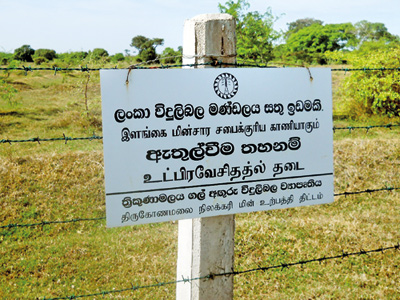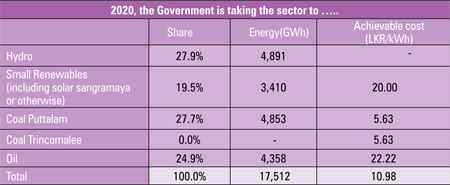Your electricity bill in 2020
 By August 2016, electricity sales growth recorded was 9.6 per cent (compared with the first eight months of 2015), the highest since 2010. So there is no relief on the demand front, to call for relief, now that Sampur power plant is delayed, suspended or cancelled. If the Sampur project went ahead, with essential additional environmental safeguards and technical/contractual amendments, relief would have come by 2020.
By August 2016, electricity sales growth recorded was 9.6 per cent (compared with the first eight months of 2015), the highest since 2010. So there is no relief on the demand front, to call for relief, now that Sampur power plant is delayed, suspended or cancelled. If the Sampur project went ahead, with essential additional environmental safeguards and technical/contractual amendments, relief would have come by 2020.
Impacts of bad decisions or indecision today on power generation, are felt only after five years, in the form of price increases and power cuts. Impacts of good decisions would take longer, to be implemented and to bear fruit, typically in ten years.
Have a look at the costs of electricity production and delivery, summarised from publications of the Public Utilities Commission (PUCSL).
2011: The first full year of operation of Norochcholai No 1 generator 2016: The first full year of operation of entire Norochcholai power plant
With Sri Lanka’s electricity prices still not adequately competitive with other countries in the region, what are the cost components that can be reduced? Certainly the highest cost is for generation energy, which includes fuel bills and purchases of renewable energy. Generation capacity costs are the next, which include fixed payments to independent power producers, depreciation in case of CEB licensee’s power plants, and fixed maintenance costs of both private and CEB power plants.
 The generation capacity cost is Rs. 4.05 per unit of electricity sold, and for the first time, quite rightly, includes the fixed costs of Norochcholai power plant reflecting depreciation, interest and maintenance costs. Costs of distribution too are high, which must decrease to internationally accepted levels of Rs. 3 per unit sold. The date was Sunday, 31st March 2002. The
The generation capacity cost is Rs. 4.05 per unit of electricity sold, and for the first time, quite rightly, includes the fixed costs of Norochcholai power plant reflecting depreciation, interest and maintenance costs. Costs of distribution too are high, which must decrease to internationally accepted levels of Rs. 3 per unit sold. The date was Sunday, 31st March 2002. The

2011: The first full year of operation of Norochcholai No 1 generator 2016: The first full year of operation of entire Norochcholai power plant
new Government of December 2001was just four months old. The Prime Minister called the Japanese Ambassador to his residence on a Sunday, mind you, to tell ‘His Excellency’ the following: “CEB engineers have misled the previous Government and the present Government. The Norochcholai Power Plant is cancelled, and therefore, Sri Lanka does not need Japanese financing to build such a power plant.
A press release was issued, on a Sunday, read out on evening news bulletins including ITN, signifying the urgent desire of the then Government to cancel the power plant. For whose benefit? Certainly not for customer benefit, as the generation cost figures show. Similarly, issuing a statement from Prime Minister’s office, the Upper Kotmale project too was cancelled in 2003. At the end, both Norochcholai and Upper Kotmale were eventually built, and contributing today about 50 per cent of the daily needs of electricity, at an energy cost of less than Rs. 6 per unit. Now look at the production costs of electricity. The table elaborates how the cost of Rs. 8.62 per unit in 2016 is structured. Rs. 7.68 per unit of electricity at the point of production, when adjusted for the loss of 10.9 per cent of energy in transmission and distribution, would be Rs. 8.62.
 The price Sri Lanka pays for renewable energy is very competitive, aren’t they? If you are happy with your electricity bills, if bills do not cause you to exclaim when you see them every month, then that is fine. This is not the case for many, especially the industries and commercial customers.
The price Sri Lanka pays for renewable energy is very competitive, aren’t they? If you are happy with your electricity bills, if bills do not cause you to exclaim when you see them every month, then that is fine. This is not the case for many, especially the industries and commercial customers.
It was again a Sunday, 15th May 2016, that the Government picked to first  announce the suspension of the Sampur power plant project (Sunday Observer). The project was about to enter construction. So the Government again works overtime on Sundays, not to build essential infrastructure projects to reduce electricity prices and stabilise the supply, but to urgently issue cancellation orders on power plants being built. By now, one by one, the new Government has either cancelled or suspended all power plants that were in the construction or planning stage. With the demand growing at 9.5 per cent per year, no significant power plants are being built, to meet the extra capacity need of about 200 MW each year.
announce the suspension of the Sampur power plant project (Sunday Observer). The project was about to enter construction. So the Government again works overtime on Sundays, not to build essential infrastructure projects to reduce electricity prices and stabilise the supply, but to urgently issue cancellation orders on power plants being built. By now, one by one, the new Government has either cancelled or suspended all power plants that were in the construction or planning stage. With the demand growing at 9.5 per cent per year, no significant power plants are being built, to meet the extra capacity need of about 200 MW each year.
So where do we go from here?
Actually, there is nowhere to go from here. Ideas to build power plants operating on gas, would take at least 10 years to materialise, produce electricity at a price higher than otherwise. Are we pursuing even the gas option in the proper manner? Information in the public domain say that “the BoI has received four proposals for gas terminals, on which decisions (meaning deals) would be made within six months”, obviously from parties known to the Government, because there was no bidding round publicly announced. With the need for competitive bidding firmly written in the law, all these “proposals” will surely fail, when contenders petition.
Besides, if the Government is not to harm the population with higher electricity bills, Sri Lanka needs only one gas terminal, not four as decided by BoI. So there will be no gas, no coal, but only diesel power plants, along with expensive renewables added in small quantities. The “solar sangramaya” will add more renewable energy at Rs. 22 per unit, work only during the day. So, here is the comparison of energy costs of generation, thanks to the Government’s great initiatives in cancelling power plants on the drawing boards, and replacing them with,……, well ……, nothing for now.
There are eight steps to disaster in electricity generation:
- Ridicule planners, plans, engineers and economists,
- Announce everything else to produce electricity is cheaper than what is given in the long term plans and the power plant projects in progress,
- Cancel all power plant projects of any significance,
- Fill newspapers with headlines saying that there are so many cheaper proposals at BoI and elsewhere to build power plants of various description,
- Announce bids for diesel power plants, also offer to buy renewables at prices even higher than diesel,
- Blackouts,
- Price increases,
- Temporary diesel power plants become permanent.
Step 1 started last September. So, the Government over the past one year, has crossed 50 per cent of the road to disaster, by reaching step 4 of the above path to disaster. Half of step 5 has also been achieved last week, with “solar sangramaya’s” price of Rs 22 per unit. The remainder of step 5 to disaster, the announcement to supply diesel power plants will be issued shortly, emulating theFebruary 2002 order by the Prime Minister to CEB to buy 200 MW of diesel power plants, weeks before Norochcholai was “cancelled” by him.
So, when money runs out to pay for diesel and the pricy renewables, blackouts will come, or prices will be increased. As seen in previous situations where the eight steps to disaster were followed to the last step(1992-1995), (1997-2000), (2002-2004) and now starting in 2015, it will be a combination of price increases and blackouts: remember 1996, 2001, 2002? Blackouts of 2004 were averted with heavy expenses on diesel.
It takes at least 15 years to educate, train and produce a power system planner, with a degree in engineering, post graduate qualifications and work experience on complex subjects of power generation, transmission, stability, economic dispatch, energy efficiency, control systems, protection, etc. The combination between engineering and economics, financial and modelling skills are essential, along with hands-on work on analytical models.
Even with such wide experience, if you ask a trained planner, a question that may seem trivial to a lay person, such as “what do you think of 100 megawatt of solar”, a trained planner would require a good one hour to explain, and one month to analyse the engineering and economic impacts. A politician decides in one minute! However, committees in the Government and those appointed by the Government, who all know better than the trained planners, are now conducting planning for the power sector, journalists included. The end result is obvious. So, get your candles ready, standby generators serviced, with plenty of money set aside to pay for diesel driven power. Blackouts are surely coming in 2018. You now know who is to be held responsible.
(The writer can be contacted
attilak@rmaenergy.lk)


